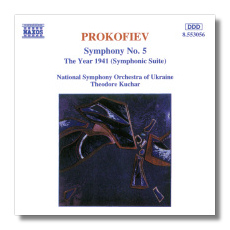
The Internet's Premier Classical Music Source
Related Links
- Prokofieff Reviews
- Latest Reviews
- More Reviews
-
By Composer
-
Collections
DVD & Blu-ray
Books
Concert Reviews
Articles/Interviews
Software
Audio
Search Amazon
Recommended Links
Site News
 CD Review
CD Review
Serge Prokofieff

Symphony #5
- Symphony #5 in B Flat Major, Op. 100 (1945)
- "The Year 1941" (Symphonic Suite), Op. 90
National Symphony Orchestra of Ukraine/Theodore Kuchar
Naxos 8.553056 DDD 57:07
Theodore Kuchar and Naxos are recording the entire Prokofieff Symphony cycle and his other orchestral works. I reviewed the disc containing Symphonies #1 and #2 previously. Two other reviews will follow. I have had the opportunity to talk with Maestro Kuchar since my previous review and will publish an interview with him in due course.
The Fifth Symphony is probably the most 'popular' of Prokofieff's. My introduction to it came with Ansermet's recording. That has been transferred to CD (which is still listed in Schwann, Opus) but the transfer suffers from shrill sound. Later, I got the chance to listen to Stokowski's on a scratchy Melodyia LP. (Shortly before he died, Jack Pfeiffer and I discussed getting this out on CD. He told me he would 'strongly suggest' it be done to the people "over there".) I have several other recordings in my collection: Jansons (who would be pulled over for speeding in Montana) Weller, Slatkin, and von Karajan. I spent a lot of time comparing these versions. Jansons was ruled out quickly, Slatkin's sound is too distant (a trademark of all of his recordings), Weller's sound is good, but it is Herbert von Karajan who rates top honors here. This is arguably one of Karajan's greatest recordings. He is not on AP, nor does he legato it to death. The Kuchar is equally captivating as Karajan, but much different.
The symphony follows an interesting slow/fast/slow/fast sequence of the movements. The opening of this symphony should sneak up on you like dawn on a misty autumn morning. Both the Karajan and Kuchar achieve this feeling. Throughout, however, Karjan has a sharper attack and sounds faster than Kuchar, but is actually slower. The sound on the Naxos recording is rather cavernous, but there is a nice soundstage, as if recorded in a cathedral. The DG recording is also resonant, but as if in a church instead. Still, the Naxos recording does not blur detail, in fact the piano is more clearly defined and placed. The contours of the performance are more rounded in Kuchar's hands, but this is not a bad thing. Throughout, Maestro Kuchar provides a more 'dreamy' feel to the piece. I would not want to be without the Karajan (this recording is evidence that he was probably a greater conductor than is currently the opinion).
Prokofieff's Fifth, in Kuchar's hands has an enigmatic quality to it. Moods segue into and out of one another. This is Prokofieff the writer of ballets (and that is no criticism) however, rather than the angular quality in von Karajan. I'd swear, especially in the two slow movements, that Shostakovich is alluded to at moments. The wiry second movement provides a droll, urbane sarcasm; listen to the woodblocks as they usher in the surreal march that drives the movement to a breath-taking close. The fourth movement opens in the same vein as the first, and quotes from it, but quickly it assumes the perky nature of the second. This time there is a bit less sarcasm, however. The 'triumph' at the close returns us to the enigma. The 'ticking' is not unlike, but not like, the close to Shostakovich's 15th Symphony. You know, for some reason Dr.Zhivago came to mind as I listened to Kuchar's interpretation.
I'd recommend you read Michael Steinberg's book, The Symphony, for an excellent discussion of this music. The insert notes here provide five paragraphs of biography and two about the music. Is this a trend on the part of Naxos? I have noticed this kind of emphasis in the past couple of discs. It is nice to have biographical/musical information, but….
Now, what about the filler? "The Year 1941", was written as a tribute to the Soviet efforts when attacked by the Nazi's. Op. 90 is in three movements. The first, "In the Struggle" is militaristic in tone. There are some interesting, absurd moments in it. Two, "In the Night" is the best of the three with a dreamy, ethereal atmosphere. Three, "For the Brotherhood of Man" seems to lack coherence, or, as Shostakovich said, "…insufficiently developed…" What else can I say but that it is well recorded.
A final verdict? The filler well may be of interest to Prokofieff fans and has its moments. The main course is very, very good. Is it great? I don't know, yet. I have to let it age, but I really like it. There you go.
Copyright © 1997, Robert Stumpf II


















